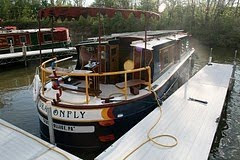 |
| Charleston is lovely this time of year-- unless you're spending your days in the engine room |
When our son Ben was two, we wanted to place him in a local daycare center. As part of the admissions process, the director came to our home, to observe us interacting with him.
It was a warm day and we were in the back yard. With his blond curls and blue eyes, Ben looked angelic, the model child. We figured we had a place in the school all wrapped up.
Ben dug round in the sandbox and pulled out a twig. Then he toddled over to our lawn chairs, twisted his sweet little face into an approximation of a grimace, and pointed the stick straight at the director. "THIS is a weapon!" he exclaimed. (This from a child who had never seen a TV show or a toy gun.)






















